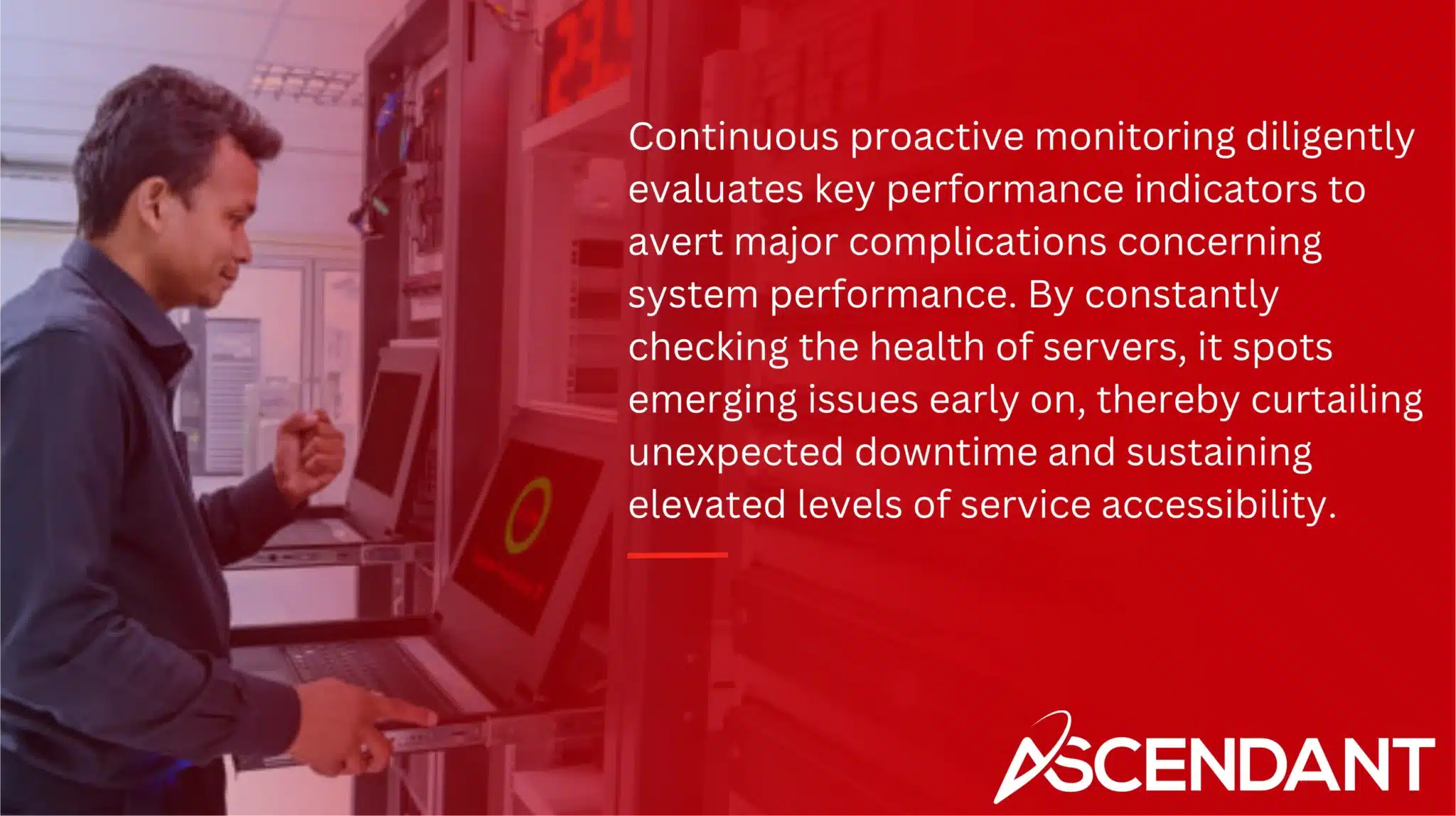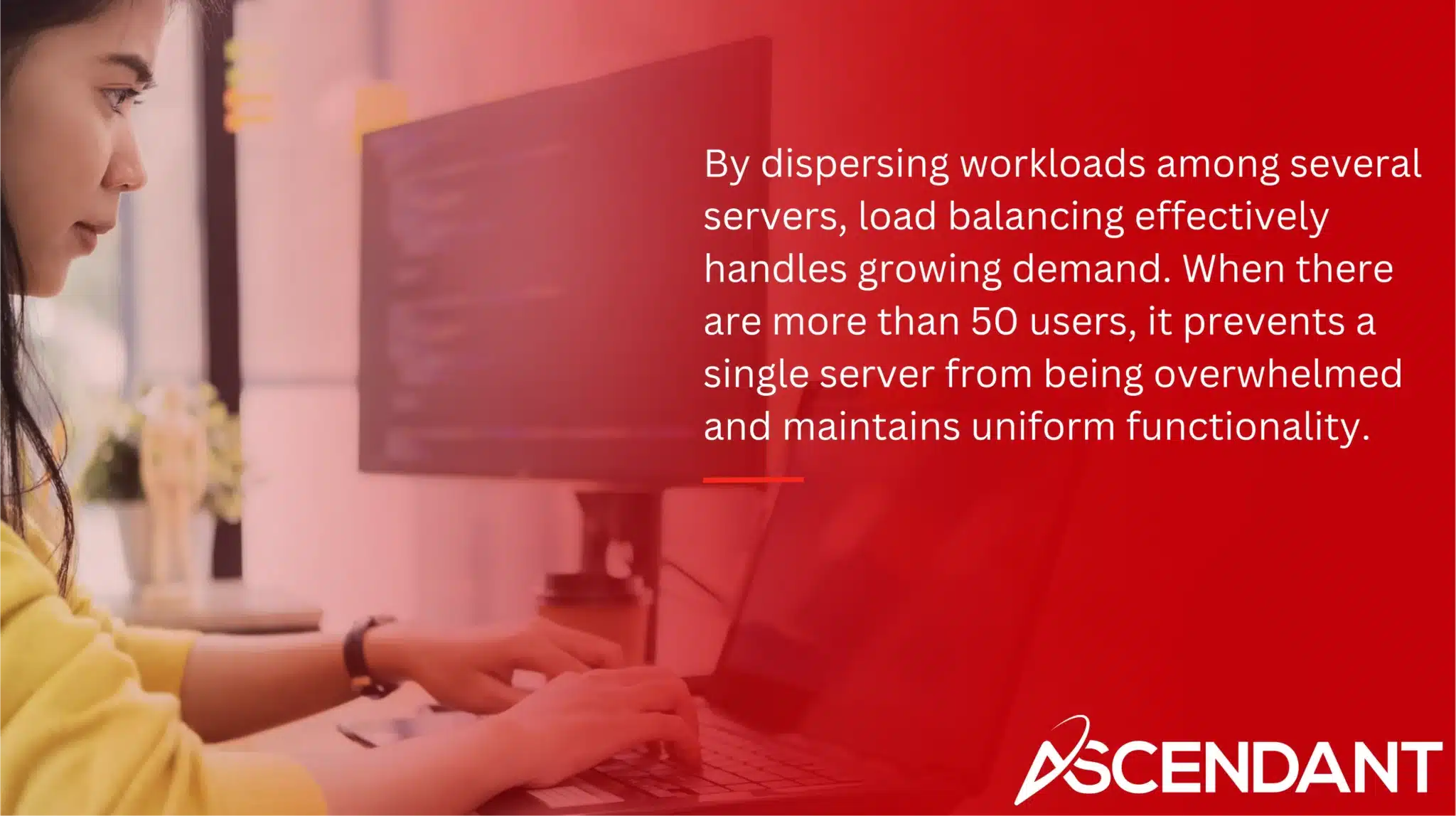Server management reduces downtime for businesses by implementing proactive monitoring, regular maintenance, redundancy, and managed services. These practices help businesses avoid disruptions, maintain productivity, and protect profitability. This article will delve into each strategy to show how server management reduces downtime for businesses significantly. By understanding these methods, companies can enhance their operational efficiency and ensure continuous service availability.
In This Article:
- The Importance of Server Management in Reducing Downtime
- Proactive Monitoring to Predict Potential Failures
- Regular Maintenance and Updates
- Implementing Redundant Systems
- Advanced Monitoring Tools and Techniques
- Comprehensive Disaster Recovery Planning
- Ensuring Maximum Uptime with Load Balancing
- Role of Managed Service Providerd (MSPs)
- Protecting Against Cyber Threats
- Reliable Data Backups and Recovery Solutions
- Training and Documentation for Staff
Key Takeaways
- Effective server management enhances uptime and prevents downtime, optimizing performance and protecting business profitability.
- Proactive monitoring and regular maintenance are critical in predicting potential failures and reducing unexpected outages to ensure continuous operations.
- Implementing redundancy, disaster recovery planning, and training for staff are essential strategies for minimizing downtime and maintaining business continuity.
The Importance of Server Management in Reducing Downtime
Server management services are essential for enhancing the uptime, security, and performance of a business’s digital infrastructure. By ensuring proper server management is in place, businesses can boost their profitability through optimized system performance and efficient resource utilization. These managed services play a crucial role in not only preventing downtime but also swiftly addressing any issues that arise to maintain steady operations.
Experiencing system downtime can lead to significant losses in productivity and result in customer discontent, both of which contribute to lost income for companies. Extended periods of downtime can be especially damaging as they may erode customer loyalty and tarnish the company’s reputation. Inadequate server management exposes organizations to an array of risks such as data loss, expensive disruptions from unplanned outages or security intrusions, and power failures that impede operations continuity—and ultimately these factors amplify the impact on revenues due to unforeseen business costs associated with halting normal activities.
Implementing effective server management strategies plays a pivotal role in sustaining continuous business processes while safeguarding vital organizational functions against interruption threats. By prioritizing meticulous attention towards managing servers effectively—companies stand better equipped at curtailing potential downtimes. Thereby upholding seamless workflow efficiency alongside reinforcing public confidence within their brand image amidst steering clear paths toward profitable gain trajectories.
Proactive Monitoring to Predict Potential Failures

Continuous proactive monitoring diligently evaluates key performance indicators to avert major complications concerning system performance. By constantly checking the health of servers, it spots emerging issues early on, thereby curtailing unexpected downtime and sustaining elevated levels of service accessibility.
Monitoring solutions employing sophisticated analytics can foresee impending failures through the analysis of patterns and irregularities in live data streams. Machine learning techniques embedded within these systems are adept at recognizing minor aberrations that could precipitate system breakdowns. Regular server examinations and diagnostic procedures unearth and rectify potential concerns before they exacerbate.
Setting up initial benchmarks for system performance is essential in proactively detecting anomalous activity. This forward-thinking strategy guarantees uninterrupted operations, diminishes periods of inactivity, and secures continuous business processes.
Regular Maintenance and Updates
Consistently conducting maintenance and updates can enhance the performance and security of company systems. Implementing routine upgrades within server management plays a vital role in significantly minimizing downtime. Essential tasks such as applying updates, managing patches, and optimizing for better performance are included in regular server upkeep.
Employing strategies that focus on proactive maintenance minimizes the chances of experiencing downtime by scheduling updates during times with minimal impact on operations. Proactive monitoring encompasses automated alerts that prompt swift action when there are discrepancies in performance, facilitating fast solutions to issues encountered. Keeping track of resource consumption is critical for boosting server function and improving reaction speeds.
Emphasizing habitual maintenance along with planned periodic upkeep is crucial to guarantee maximum uptime, seamless workflow continuity, and heightened efficiency thanks to preventive maintenance efforts.
Implementing Redundant Systems
Redundant systems offer alternative solutions to maintain uninterrupted service in the event of hardware malfunctions. These redundancies, including auxiliary internet connections and cloud-based backups, support sustained functionality amid disruptions.
Consistent evaluation confirms that these backup mechanisms operate as intended when real failures occur. The adoption and upkeep of both critical and redundant systems are instrumental in minimizing downtime while bolstering business continuity by facilitating the swift restoration of essential operations.
Advanced Monitoring Tools and Techniques
Predictive maintenance employs data analytics to foresee potential server problems, thus improving system uptime. By analyzing data, the likelihood of equipment failure can be predicted and consequently, server dependability is improved.
Intrusion detection systems are designed to spot atypical activity within traffic patterns which may signify impending security risks. The real-time surveillance functionality sends instant alerts about performance disruptions, allowing for swift action that helps reduce downtime. These monitoring tools have alert mechanisms programmed to trigger notifications when pre-set limits are reached, thereby streamlining reaction times.
Automated remediation embedded in monitoring solutions resolves common issues autonomously, increasing operational efficiency. Cutting-edge monitoring technologies harness machine learning capabilities to refine anomaly identification precision as they continue to gather more information over time.
Comprehensive Disaster Recovery Planning
A robust disaster recovery strategy minimizes downtime and protects critical business data. Effective business continuity planning minimizes downtime by identifying and protecting critical applications during outages. Managed service providers align disaster recovery plans with business goals, focusing on recovery time and data loss objectives.
Regular testing ensures backup systems maintain data integrity and support successful recovery in case of loss. Cloud disaster recovery solutions allow organizations to pay for only the resources they use, avoiding upfront hardware investments. Setting appropriate Recovery Time Objectives (RTO) and Recovery Point Objectives (RPO) balances cost and operational continuity.
Geographical redundancy in disaster recovery ensures systems are replicated in different locations. Prioritizing IT systems based on criticality allows effective resource management and rapid recovery of essential operations.
Ensuring Maximum Uptime with Load Balancing

By dispersing workloads among several servers, load balancing effectively handles growing demand. When there are more than 50 users, it prevents a single server from being overwhelmed and maintains uniform functionality. Spreading incoming requests over numerous servers aids in circumventing delays and performance complications.
Through load balancing, user experience is enhanced with faster response times, even amidst periods of high traffic volume. It also promotes scalability by allowing for the seamless addition of new servers as an organization grows.
Load balancing is instrumental in achieving maximum uptime, which enables businesses to operate without interruption and minimize downtime.
Role of Managed Service Providers (MSPs)
Managed services aim to maximize businesses’ uptime as their key objective. Managed IT services minimize downtime and ensure operational efficiency. Partnering with IT managed services providers enhances IT capabilities and reduces downtime.
Managed service providers offer expertise and advanced tools for optimal performance and availability. Regular monitoring and maintenance by managed service providers prevent system issues before they lead to downtime. Managed service providers offer 24/7 monitoring and expert support for business operations.
Aligning with a reliable managed services provider significantly reduces downtime and enhances overall IT strategy. Managed services enable predictive maintenance and efficient problem resolution, reducing downtime. Adopting a proactive IT model through MSPs leads to greater efficiency, cost savings, and smoother operations.
Protecting Against Cyber Threats
Frequent updates to software enhance its performance and bolster security by addressing new cyber threats. Consistently applying security measures in the form of patches is critical for preserving system integrity and averting data breaches. Neglecting these updates can lead to substantial financial repercussions, legal complications, and erosion of consumer confidence.
A strong patch management approach involves recognizing weaknesses, determining which patches should be applied first based on their importance, and executing them effectively. Using automation tools simplifies this process by guaranteeing that updates are carried out promptly. To minimize any negative impact on operations, it’s advisable to test these patches in a controlled setting before they go live. For the purposes of tracking adherence to security standards, maintaining records of patch management activities is crucial.
When devising strategies for prioritizing patches, it’s important to evaluate both the possible consequences if exploited and how likely exploitation might occur. Incorporating robust security measures is key in safeguarding businesses from online threats while also promoting uninterrupted business operations (business continuity).
Reliable Data Backups and Recovery Solutions
Regular backups act as a defense against severe data loss and potential security issues. It is advised to maintain three duplicates of your data on two distinct storage forms, with one copy kept off-site consistently as per the 3-2-1 backup rule. By adding redundancy in this manner, you can greatly diminish the chance of devastating data loss if unforeseen disruptions occur.
By automating the process of backing up information, it’s possible to cut down on mistakes made by people and enhance the speed at which data can be restored. As more businesses move towards cloud-based services, there is an increasing need for backup systems that are compatible with these online platforms.
Dependable mechanisms for both saving and retrieving data play a crucial role in minimizing operational interruptions and maintaining business continuity.
Training and Documentation for Staff
Knowledgeable staff effectively prevent and manage downtime incidents. Frequent training and well-documented IT checklists mitigate human error in server management. Capturing knowledge from experienced workers ensures vital operational insights are passed to newer staff.
Regular refresher training on infrequent tasks helps workers maintain proficiency and reduce errors. Investing in staff training and documentation enhances server management practices and reduces downtime.
Summary
In summary, it is vital for the long-term success and profitability of a business to prioritize server management as an essential component. Effective strategies such as engaging in proactive monitoring, conducting regular maintenance, establishing redundant systems, utilizing advanced monitoring tools for comprehensive disaster recovery planning, employing load balancing techniques, and collaborating with managed service providers for additional support against cyber threats are pivotal in minimizing downtime. Secure data backups and investment in staff training Contribute to maximizing uptime— all fundamental practices necessary for maintaining business continuity and securing a competitive advantage.
 Frequently Asked Questions
Frequently Asked Questions
What is proactive monitoring, and why is it important?
Proactive monitoring is a continuous assessment of server health that identifies potential issues before they lead to downtime. Its importance lies in maintaining higher service availability and minimizing unexpected outages.
How can regular maintenance and updates reduce downtime?
Consistently performing updates and maintenance can notably reduce instances of downtime by improving system functionality and targeting possible security weaknesses, which guarantees that systems operate both effectively and safely.
Adopting this proactive strategy helps in minimizing the dangers that might result in system breakdowns.
What role do redundant systems play in minimizing downtime?
Having redundant systems in place is crucial for reducing downtime because they provide alternative options and swift failover functions that guarantee uninterrupted service even when hardware issues arise.
Taking such a proactive stance greatly improves the dependability of the system.
How do managed service providers (MSPs) help in reducing downtime?
Managed service providers (MSPs) effectively reduce downtime through expertise, proactive monitoring, and 24/7 support, ensuring continuous system performance and reliability.
Engaging an MSP enhances your overall IT strategy and minimizes disruptions.
Why are reliable data backups and recovery solutions important for businesses?
Reliable data backups and recovery solutions are essential for protecting against data loss and ensuring business continuity. They enable rapid recovery during unexpected outages, safeguarding against security vulnerabilities.

